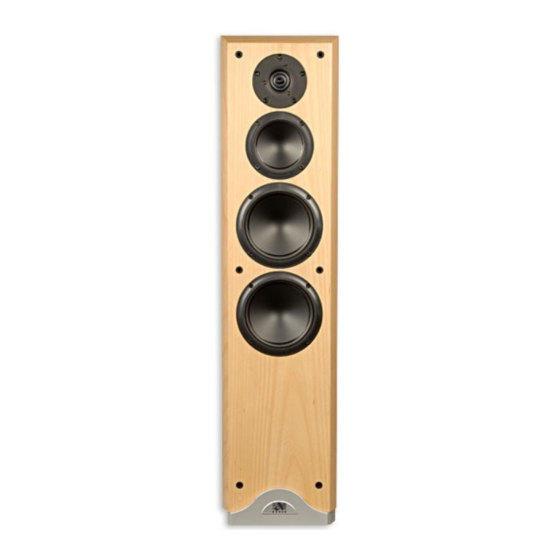
Advertisement
Quick Links
Congratulations on choosing a pair of "Aaron" loudspeakers. We at Aaron have gone to the upmost
trouble to ensure your continuing satisfaction for many years to come. Every individual speaker must
meet our exacting specifications with regards to performance and craftsmanship before it is allowed to
leave our factory.
IT IS ABSOLUTELY VITAL YOU READ
THIS NEXT SECTION!
OTHERWISE IT COULD CAUSE YOU A
LOT OF NEEDLESS EXPENSE
The single biggest bone of contention that customers have with speaker manufacturers is
caused when a speaker is damaged by too much power input or by amplifier distortion. This is not
covered by warranty as it is deemed to be customer abuse, often the customer feels this problem
should not arise. So in an effort to further improve our relationship with you, (our valued
customer), there is something we will try to help you understand in an effort to circumvent this
potential problem.
As a manufacturer it is impossible to protect or prevent you the consumer from damaging the
speaker when one of the two following things happen:
1: Using an amplifier that has too much output for the speakers capacity.
2: Causing the amplifier to distort by turning up the volume too high.
The first problem is easy to avoid. When you purchase an amplifier you must take note of its`
power output. This will tell you the minimum size speaker to purchase. For instance if you
purchase a 100W speaker then the amplifier must be rated at 100W or less. By the way, it is
perfectly alright to use a 400W speaker with a 10W amplifier there is no limit in that direction but as
a general rule an amplifier closer to the rating of the speaker will sound a little better. If the speaker
is very efficient the improvement will be less obvious.
The second problem is far harder to understand and avoid. You see, even if the amplifier power
is smaller than the speaker it is still possible to damage the speaker. This is caused by what is
known as distortion. An amplifier distorts when the volume control is turned up too high forcing the
amplifier past its rated power output. So an amplifier rated at 100W can be forced to put out 120W.
But 20W of that power is distortion and this is what damages your speaker. The hard part is to
know when your amplifier has passed its limit and is distorting. The position of your volume control
will not tell you, if the source output, (the source is a DVD player, CD player or Tape deck etc.) is
high then the amplifier may distort with the volume control at 12 o`clock but on the other hand if
the source has a low output the amplifier may not distort until 3 o`clock. The only way to tell is by
listening carefully to the music quality. Don`t turn the volume control any more if the sound
becomes harsher, less tight and a bit blaring. That holds even if the volume control is less than half
way.
INSTRUCTIONS
Advertisement

Summary of Contents for Aaron HCC-300
- Page 1 Congratulations on choosing a pair of “Aaron" loudspeakers. We at Aaron have gone to the upmost trouble to ensure your continuing satisfaction for many years to come. Every individual speaker must meet our exacting specifications with regards to performance and craftsmanship before it is allowed to leave our factory.
- Page 2 TIMES WHEN YOUR SPEAKERS ARE AT MOST RISK FROM YOU. 1: Parties are the most common cause of speakers being damaged by too much power or by distortion, it often happens because of a desire to have the music loud. Distortion is harder to detect because it is masked by lots of other noise.
- Page 3 Having said that, most reputable amplifier manufacturers allow for a small safety margin, for instance it is not likely to cause any problem if you connect an “AARON” 6 ohm speaker to an 8 ohm rated amplifier output. Should you wish to put two speakers on each amplifier output, a little more care is required.
-
Page 4: Mounting Options
There is an added mounting option we have provided for you in the HSS-600, HSS-300 and HCC-300. They each have a 3/8 whitworth screw thread mounted in the back of the cabinet. This thread suits the best wall mounting bracket on the market (in our opinion). - Page 5 HSS-600 HCC-300 A T T A C H I N G S P I K E S HSS-300 By attaching the supplied spikes to speakers it can further enhance the sound quality, especially if the floor construction is not rigid or covered with carpet.
-
Page 6: Caring For Your Speakers
Midrange 132mm Woofer Hyperboloid 295mmH Cabinet 187mmW Dimensions 196mmD Enclosure Black, Jarrah Finish and Beech Weight 5.5kg each HCC-300 HMF-600 100Hz-20KHz 50Hz-20KHz 1db) 1db) 20-100W per 20-150W per channel undistorted channel undistorted 89db 89db 6ohms 6ohms 5kHz 300Hz/5kHz 40mm dual...

